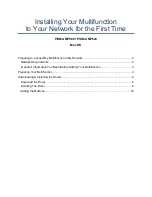
Lexmark
T430dn
BUYERS LABORATORY INC.
Lab Test Report
© 2004 Buyers Laboratory Inc. WARNING: This material is copyrighted by Buyers Laboratory Inc. and is the sole property of Buyers Laboratory. Duplication of this proprietary report or excerpts from this report, in any manner,
whether printed or electronic (including, but not limited to, copying, faxing, scanning or use on a fax-back system), is illegal and strictly forbidden without written permission from Buyers Laboratory. Violators will be prosecuted
to the fullest extent of the law. To purchase reprints of any BLI reports or articles, contact BLI at (201) 488-0404. Buyers Laboratory Inc., 20 Railroad Avenue, Hackensack, NJ 07601. Contact us at [email protected].
2
Connectivity
While parallel and USB ports are standard and a wide range of network interfaces are available as
options, the Lexmark T430dn was connected to BLI’s test network via its standard 10/100BaseTX
Ethernet interface. Bundled with the unit is Lexmark’s Web-based print management utility, MarkVision
Professional. MarkVision Professional is a very flexible and powerful network management tool.
Capable of identifying all Lexmark and even non-Lexmark printers on a network, the utility makes
setup on the network easy.
MarkVision Professional provides extensive device status and print job status monitoring capabilities,
including real-time feedback when a client module is installed at the workstation or limited real-time
feedback when accessing the utility via a Web browser. In addition, MarkVision Professional 10.2
includes enhanced user authentication and security features to limit unauthorized access, such as
print server password conformance for supported devices, LDAP user authentication utilizing SSL or
Kerberos and Print Permissions Technology that allows the administrator to restrict access to certain
printer functions.
Administrators may limit access to the MarkVision Professional Web server by assigning privileges to
individual users and/or groups. Administrators can use MarkVision Professional to create sub-folders
with filters attached, such as low on toner, so that any device reporting low toner will appear in that
folder. And, with MarkVision Messenger, a component of MarkVision Professional, administrators
can receive e-mail alert messages based on errors or alerts, such as low on toner, as well as take an
inventory of all printers on the network, record all printing data and export that data to a database or
spreadsheet.
The Lexmark T430dn can also be managed via its embedded Web page. By accessing the page via a Web
browser, the user or administrator can view printer status, the amount of consumables (such as toner
and the maintenance kit) remaining, view and modify printer settings, generate usage and configuration
reports and view basic printer information (such as memory and options installed). In addition, users
and administrators can also obtain feedback via a status window that may be accessed from either print
driver. The status window provides real-time pop-up messages regarding status information and may be
configured by the end user to open whenever a print job is sent, only when an error occurs at the device,
only when a warning is sent regarding the device or print job, or to remain minimized on the taskbar
where the icon will flash until the window is opened by the user.
BLI technicians also found the T430dn’s PCL and PostScript print drivers well-laid-out and easy to
use. Lexmark provides PCL 6 and PostScript 3 drivers for Windows 95, 98, NT 40, 2000, Me and
XP, Macintosh, UNIX, Linux and IBM iSeries. Further enhancing ease of use are the unit’s simple
procedures for loading paper, adjusting paper drawers and clearing paper jams. The unit also employs
a user-replaceable all-in-one print cartridge (containing both the toner and the drum), which BLI
technicians found easy to replace, and a fuser kit, which did not require replacement during the test
period.
Other noteworthy features include the T430dn’s standard and maximum memory capacities of 64
MB and 320 MB, respectively, both of which are competitive. Lexmark also offers its optional Optra
Forms software, a printer-based batch document formatting and electronic forms printing solution that
allows forms, fonts, and formatting information to be stored in the printer. Data sent to the printer is
reformatted, positioned on the page, converted to bar codes if required, and merged with the encoded
form or page as it prints. The addition of the optional Optra Forms 16- or 32-MB Flash Card allows
users to store many commonly used documents and forms (designed with Optra Forms software) in
flash memory inside the printer. Another option, Lexmark’s ImageQuick Card, allows users to store
GENERAL APPRAISAL
(CONTINUED)
































